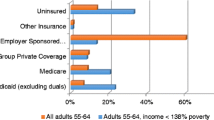Abstract
The Affordable Care Act of 2010 (ACA) includes provisions related to the cost and quality of the care received by dually eligible Medicare and Medicaid beneficiaries. More than nine million Medicare beneficiaries are also enrolled in the Medicaid program. Sixty percent are age 65 years and older. Many dual-eligible patients and their caregivers experience difficulties navigating the health care system. The division of responsibility and funding across the Medicare and Medicaid programs only intensifies these problems. Prior to the passage of the ACA, special needs plans, authorized in 2003, focused on specific subtypes of dual eligible beneficiaries with the intent to integrate the financing and delivery of care for the full range of health care needs. The Program of All-Inclusive Care for the Elderly stands out as a successful example of a seamlessly integrated program that brings together Medicare and Medicaid benefits into one delivery system. The ACA established the Federal Coordinated Health Care Office (FCHCO). In 2011, the FCHCO began the Medicare-Medicaid Financial Alignment Demonstration. The program allows state Medicaid offices to develop innovative approaches to improve the coordination of care for the dual eligible population, while adding efficiencies and incentives that will reduce the cost of care. At the start of 2014, eight States had completed signed agreements with CMS to initiate demonstrations. Geriatrics providers’ clinical leadership, when combined with consumer advocacy efforts, is essential to ensure that the financial incentives in the integrated care demonstrations are aligned to ensure optimal care for vulnerable older adults.
Access this chapter
Tax calculation will be finalised at checkout
Purchases are for personal use only
Similar content being viewed by others
References
Data book: Beneficiaries dually eligible for Medicare and Medicaid. MedPAC|MACPAC. 2013. http://www.medpac.gov/documents/Dec13_Duals_DataBook.pdf. Accessed 3 June 2014.
Henry J Kaiser Family Foundation. Focus on health reform. 2011 (#8192). www.kff.org. Accessed 11 Jan 2013.
MEDPAC. Dual eligible beneficiaries. In: A data book: health care spending and the Medicare program. 2011. www.medpac.gov. Accessed 11 Jan 2001.
Branch E, Bella M. What is the focus of the integrated care initiatives aimed at Medicare-Medicaid Beneficiaries? J Am Soc Aging. 2013;37:6–12.
Davenport K, Hodin RM, Feder J. The “dual eligible” opportunity. Center for American Progress and Community Catalyst. www.americanprogress.org. Accessed 11 Jan 2013.
Social Security Act. http://www.ssa.gov/OP_Home/ssact/title18/1812.htm. Accessed 3 June 2014.
Frye JE, Center for Medicare Advocacy. Dually eligible for Medicare and Medicaid. Slide presentation at National Health Policy Forum. Washington, DC: Reserve Officers Club; 2003.
MEDPAC. Dual eligible beneficiaries: an overview, Chapter 3. In: Report to the congress: new approaches in medicare. Medicare Payment Advisory Commission 2004. pp. 71–92. http://www.medpac.gov/documents/june04_entire_report.pdf. Accessed 18 Jul 2014.
Kaiser Family Foundation. Medicaid update: expenditures and beneficiaries in 1994 – policy brief. 1996. http://kff.org/medicaid/issue-brief/medicaid-update-expenditures-and-beneficiaries-in-1994/. Accessed 3 June 2014.
Milligan CJ, Woodcock CH. Medicare advantage special needs plans for dual eligibles: a primer. Issue Brief Commonw Fund. 2008;31. 1108
Gold M, Jacobson G, Damico A, Neuman T. Issue brief: medicare advantage 2013 spotlight. Kaiser Family Foundation. 2013. http://kaiserfamilyfoundation.files.wordpress.com/2013/06/8448.pdf. Accessed 3 Apr 2014.
Medicare Special Needs Plans: A Critical Need for Quality Standards of Care. 2008. http://www.communitycatalyst.org/doc-store/publications/medicare_special_needs_plans_a_report.pdf. Accessed 3 June 2014.
Milligan CJ, Woodcock CH. Coordinating care for dual eligibles: options for linking state medicaid programs with medicare advantage special needs plans. Issue Brief Commonw Fund. 2008;1109;32.
Medicare Advantage/Part D Contract and Enrollment Data; Special Needs Plans Comprehensive Report. Centers for Medicaid and Medicare Services. 2008. http://www.cms.hhs.gov/MCRAdvPartDEnrolData/. Accessed 4 Apr 2014.
PACE in the States. National PACE Association. http://www.npaonline.org/website/download.asp?id=1741&title=PACE_in_the_States. Accessed 4 Apr 2014.
Chatterji P, Burstein NR, Kidder D, White A. Evaluation of the Program of All-inclusive Care for the Elderly (PACE) demonstration: the impact of PACE on participant outcomes. Baltimore; Centers for Medicare & Medicaid Services, Department of Health and Human Services. 1998.
MEDPAC. Care needs for dual eligibles, Chapter 6. Report to the congress: new approaches in medicare. Medicare Payment Advisory Commission 2004. pp. 145–163. http://www.medpac.gov/documents/june04_entire_report.pdf. Accessed 18 Jul 2014.
Burwell B, Saucier P. Managed long-term services and supports programs are a cornerstone for fully integrated care. Generations. 2013;37:33–8.
Browdie R. Why is care coordination so difficult to implement? Generations. 2013;37:62–7.
Medicare-Medicaid Coordination Office. Centers for Medicare and Medicaid Services. http://www.cms.gov/Medicare-Medicaid-Coordination/Medicare-and-Medicaid-Coordination/Medicare-Medicaid-Coordination-Office/. Accessed 23 Dec 2013.
Henry J. Kaiser Family Foundation’s. Affordable care act provisions relating to the care of dually eligible Medicare and Medicaid beneficiaries. 2011. http://kff.org/health-reform/issue-brief/affordable-care-act-provisions-relating-to-the/
Medicaid Coverage of Medicare Beneficiaries (Dual Eligibles) At a Glance: Medicare Learning Network. Department of Health and Human Services, Centers for Medicare and Medicaid Services. ICN 006977. 2013. http://www.cms.gov/Outreach-and-Education/Medicare-Learning-Network-MLN/MLNProducts/downloads/medicare_beneficiaries_dual_eligibles_at_a_glance.pdf. Accessed 6 Apr 2014.
Kaiser Family Foundation. State demonstration proposals to integrate care and align financing and/or administration for dual eligible beneficiaries. 2014. http://kff.org/medicaid/fact-sheet/state-demonstration-proposals-to-integrate-care-and-align-financing-for-dual-eligible-beneficiaries/. Accessed 4 Oct 2014.
Kaiser Family Foundation. Explaining the state integrated care and financial alignment demonstrations for dual eligible beneficiaries. 2012. http://kaiserfamilyfoundation.files.wordpress.com/2013/01/8368.pdf. Accessed 23 Dec 2013.
Bodenheimer T, Wagner EH, Grumbach K. Improving primary care for patients with chronic illness. JAMA. 2002;288:1775–9.
Cohen HJ, Feussner JR, Weinberger M, et al. A controlled trial of inpatient and outpatient geriatric evaluation and management. N Engl J Med. 2002;346:905–12.
Hirth V, Baskins J, Dever-Bumba M. Program of All-inclusive Care (PACE): past, present, and future. J Am Med Dir Assoc. 2009;10:155–60.
Counsell SR, Callahan CM, Clark DO, Tu W, Buttar AB, Stump TE, et al. Geriatric care management for low-income seniors: a randomized controlled trial. JAMA. 2007;298(22):2623–33.
Coleman EA, Parry C, Chalmers S, et al. The care transitions intervention. Arch Intern Med. 2006;166:1822–8.
Naylor MD, Aiken LH, Kurtzman ET, et al. The importance of transitional care in achieving health reform. Health Aff. 2011;30:746–54.
Author information
Authors and Affiliations
Corresponding author
Editor information
Editors and Affiliations
Rights and permissions
Copyright information
© 2015 Springer International Publishing Switzerland
About this chapter
Cite this chapter
Warshaw, G., DeGolia, P.A. (2015). Medicare and Medicaid Coordination: Special Case of the Dual Eligible Beneficiary. In: Powers, J. (eds) Healthcare Changes and the Affordable Care Act. Springer, Cham. https://doi.org/10.1007/978-3-319-09510-3_7
Download citation
DOI: https://doi.org/10.1007/978-3-319-09510-3_7
Published:
Publisher Name: Springer, Cham
Print ISBN: 978-3-319-09509-7
Online ISBN: 978-3-319-09510-3
eBook Packages: MedicineMedicine (R0)




